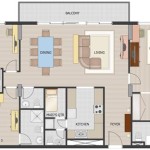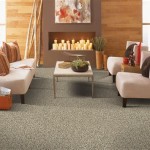How to Coordinate Rugs in an Open Floor Plan
Open floor plans have become a popular design choice in modern homes, offering a sense of spaciousness and facilitating a seamless flow between living areas. However, this design aesthetic presents unique challenges when it comes to interior decorating, particularly in defining distinct zones while maintaining a cohesive visual appeal. The strategic use of rugs is crucial in achieving this balance. Successfully coordinating rugs in an open floor plan involves careful consideration of various factors, including color palettes, patterns, textures, rug sizes, and the overall style of the home. This guide provides in-depth information on how to effectively use rugs to create a harmonious and functional open floor plan.
Understanding the Purpose of Rugs in Open Floor Plans
Rugs in open floor plans serve a multitude of purposes beyond mere floor covering. They act as visual anchors, delineate different zones within the space, and contribute significantly to the overall aesthetic. Without rugs, large open areas can feel cavernous and undefined. The thoughtful selection and placement of rugs can instantly add warmth, texture, and personality to the space, transforming it into a more inviting and comfortable environment.
One of the primary functions of rugs in an open floor plan is to define distinct areas. In a combined living and dining space, for example, a rug can visually separate the seating area from the dining table and chairs. This creates a sense of order and organization, making the space feel more intentional and less chaotic. Similarly, rugs can be used to delineate a home office area or a reading nook within a larger living room.
Beyond defining spaces, rugs also serve as a unifying element. By choosing rugs with complementary colors, patterns, or textures, it is possible to create a cohesive visual flow throughout the open floor plan. This helps to tie the different areas together, preventing them from feeling disconnected or disjointed.
Finally, rugs contribute significantly to the aesthetic appeal of the space. They can introduce color, pattern, and texture, adding visual interest and personality. A well-chosen rug can become a focal point in a room, drawing the eye and setting the tone for the entire space. The texture of a rug can also add a layer of tactile comfort, making the space feel warmer and more inviting.
Key Considerations for Coordinating Rugs
Coordinating rugs in an open floor plan requires careful planning and attention to detail. Several key factors must be considered to achieve a cohesive and visually appealing result. These include color palette, pattern selection, texture considerations, rug size and placement, and overall style consistency.
Color Palette: Choosing a cohesive color palette is essential for creating a harmonious look in an open floor plan. The rugs should complement the existing furniture, wall colors, and accessories. One approach is to select rugs that feature variations of the same color family. For example, if the living room features a rug with shades of blue and gray, the dining area rug could incorporate similar hues, perhaps with a different pattern or intensity. Alternatively, consider using complementary colors to create visual interest. A rug with warm tones in the living room could be paired with a rug featuring cool tones in the dining area, creating a balanced and dynamic look. The key is to ensure that the colors work together harmoniously and do not clash.
Pattern Selection: The patterns of the rugs should also be carefully considered. While it is not necessary for the rugs to have identical patterns, they should complement each other. One option is to choose rugs with similar geometric patterns in different scales. For instance, a large-scale geometric pattern in the living room could be paired with a smaller-scale geometric pattern in the dining area. Another approach is to mix patterns with solids. A patterned rug in one area can be balanced by a solid-colored rug in another. This approach helps to create a sense of visual interest without overwhelming the space. It is important to avoid using too many competing patterns, as this can create a chaotic and disorganized look. If opting for multiple patterns, ensure they share a common color or design element to tie them together.
Texture Considerations: The texture of the rugs can also contribute to the overall aesthetic. Mixing different textures can add depth and visual interest to the space. For example, a plush, high-pile rug in the living room can be paired with a flatweave rug in the dining area. This creates a tactile contrast that is both visually appealing and functionally appropriate. Consider the intended use of each area when selecting rug textures. High-traffic areas, such as hallways and entryways, may benefit from durable, low-pile rugs, while softer, more luxurious textures may be preferred in areas where comfort is a priority. Paying attention to texture can add a sensory dimension to the design, making the space feel more inviting and comfortable.
Rug Size and Placement: The size and placement of the rugs are crucial for defining spaces and creating a sense of balance. As a general rule, the rugs should be large enough to anchor the furniture in each area. In the living room, the rug should ideally extend under at least the front legs of the sofa and chairs. In the dining area, the rug should be large enough to accommodate all of the chairs, even when they are pulled out from the table. Avoid using rugs that are too small or too large for the space, as this can disrupt the visual balance and make the area feel awkward. The placement of the rugs should also be carefully considered. They should be positioned in a way that defines the boundaries of each area and creates a clear sense of separation. Consider the flow of traffic when placing rugs, ensuring that there are no obstacles or tripping hazards. A well-placed rug can subtly guide the eye and create a more inviting and functional space.
Overall Style Consistency: Maintaining a consistent overall style is essential for creating a cohesive look in an open floor plan. The rugs should complement the existing furniture, decor, and architectural style of the home. Whether the style is modern, traditional, bohemian, or eclectic, the rugs should reflect and enhance that aesthetic. Avoid mixing styles that clash or compete with each other. For example, a traditional oriental rug may not be the best choice for a modern, minimalist space. Instead, opt for rugs that are consistent with the overall design theme. This will help to create a sense of harmony and continuity throughout the open floor plan.
Practical Tips for Implementing Rug Coordination
Successfully coordinating rugs in an open floor plan requires a strategic approach. Here are some practical tips to help in the implementation process:
Start with a Neutral Base: If unsure where to begin, consider using neutral-colored rugs as a base. Neutral tones such as beige, gray, and ivory are versatile and can easily complement a variety of color palettes and styles. These rugs can serve as a foundation upon which to build the design, allowing for more flexibility in choosing furniture and accessories.
Consider a Statement Rug: Choose one rug to act as a statement piece. This rug can be the most visually striking in terms of color, pattern, or texture. Use this statement rug as a starting point and then select other rugs that complement it. This approach helps to create a focal point and adds visual interest to the space.
Use Visual Aids: Before making any purchases, create visual aids to help visualize the rugs in the space. This can be done by using online design tools or simply by creating a mood board with images of the rugs and furniture. This will help to ensure that the rugs work together harmoniously and fit the overall design scheme.
Test Rug Samples: Obtain rug samples before committing to a purchase. This allows to see how the colors and textures look in the actual space and how they interact with the existing lighting and furniture. Place the samples in different areas of the open floor plan to get a sense of how they will look under different conditions.
Maintain Consistent Spacing: Pay attention to the spacing between the rugs. Ideally, there should be a consistent amount of bare flooring between each rug. This helps to create a sense of balance and prevents the space from feeling cluttered. Avoid overlapping rugs or placing them too close together, as this can disrupt the visual flow.
Consider the Underlay: Use rug pads or underlays beneath the rugs. This not only helps to protect the flooring but also provides cushioning and prevents the rugs from slipping or sliding. A good-quality rug pad can also extend the lifespan of the rug by preventing wear and tear.
Don't Be Afraid to Experiment: Coordinating rugs in an open floor plan is a process of experimentation. Don't be afraid to try different combinations of colors, patterns, and textures until the desired look is achieved. There are no hard and fast rules, so be creative and have fun with the process.
By carefully considering these factors and implementing these practical tips, it is possible to successfully coordinate rugs in an open floor plan, creating a harmonious, functional, and visually appealing space.

Design Dilemma How To Coordinate Rugs

How To Coordinate Rugs A Design Dilemma Solved Worthing Court

How To Coordinate Rugs A Design Dilemma Solved Worthing Court

How To Coordinate Rugs In An Open Floor Plan Havenly Blog Interior Design

How To Coordinate Rugs A Design Dilemma Solved Worthing Court

Design Dilemma How To Coordinate Rugs

How To Coordinate Rugs In An Open Floor Plan Havenly Blog Interior Design

Design Dilemma How To Coordinate Rugs

Design Dilemma How To Coordinate Rugs

Coordinating Rugs In An Open Concept Floor Plan Stefana Silber








